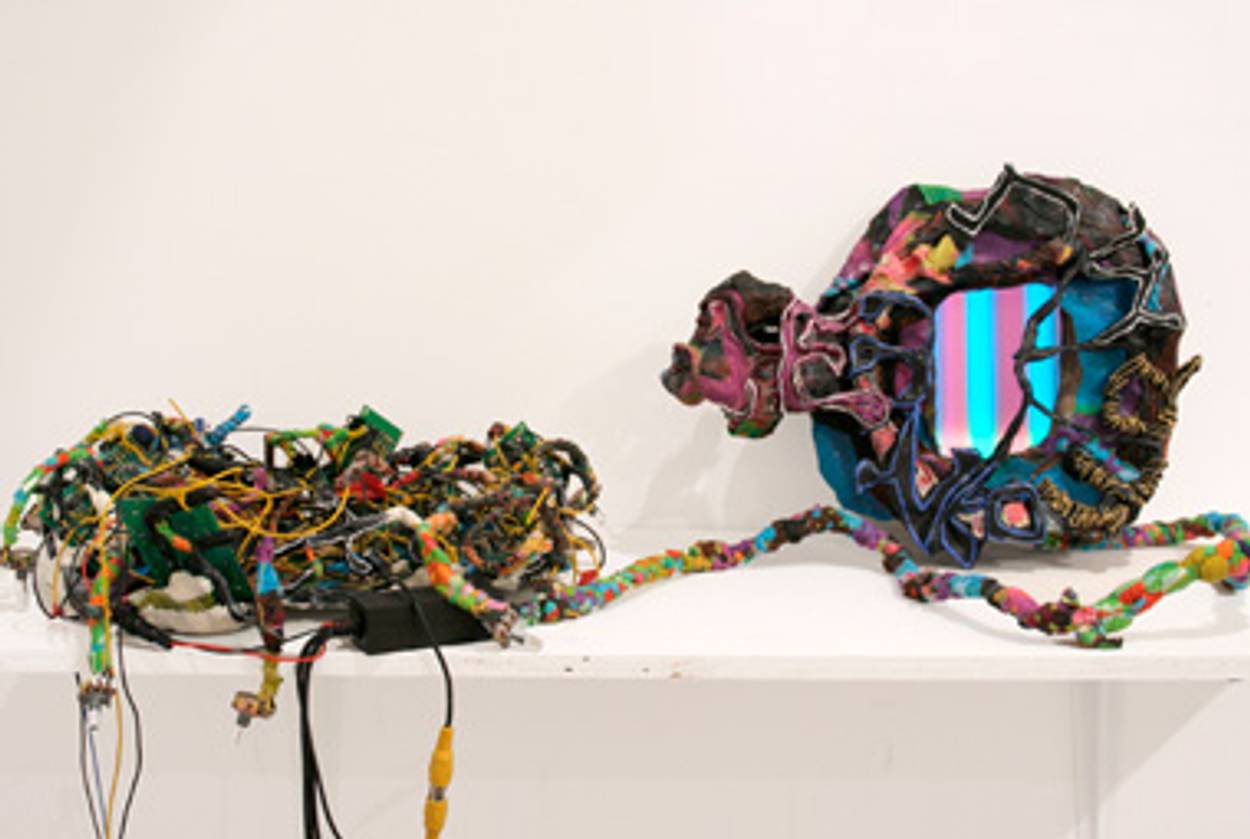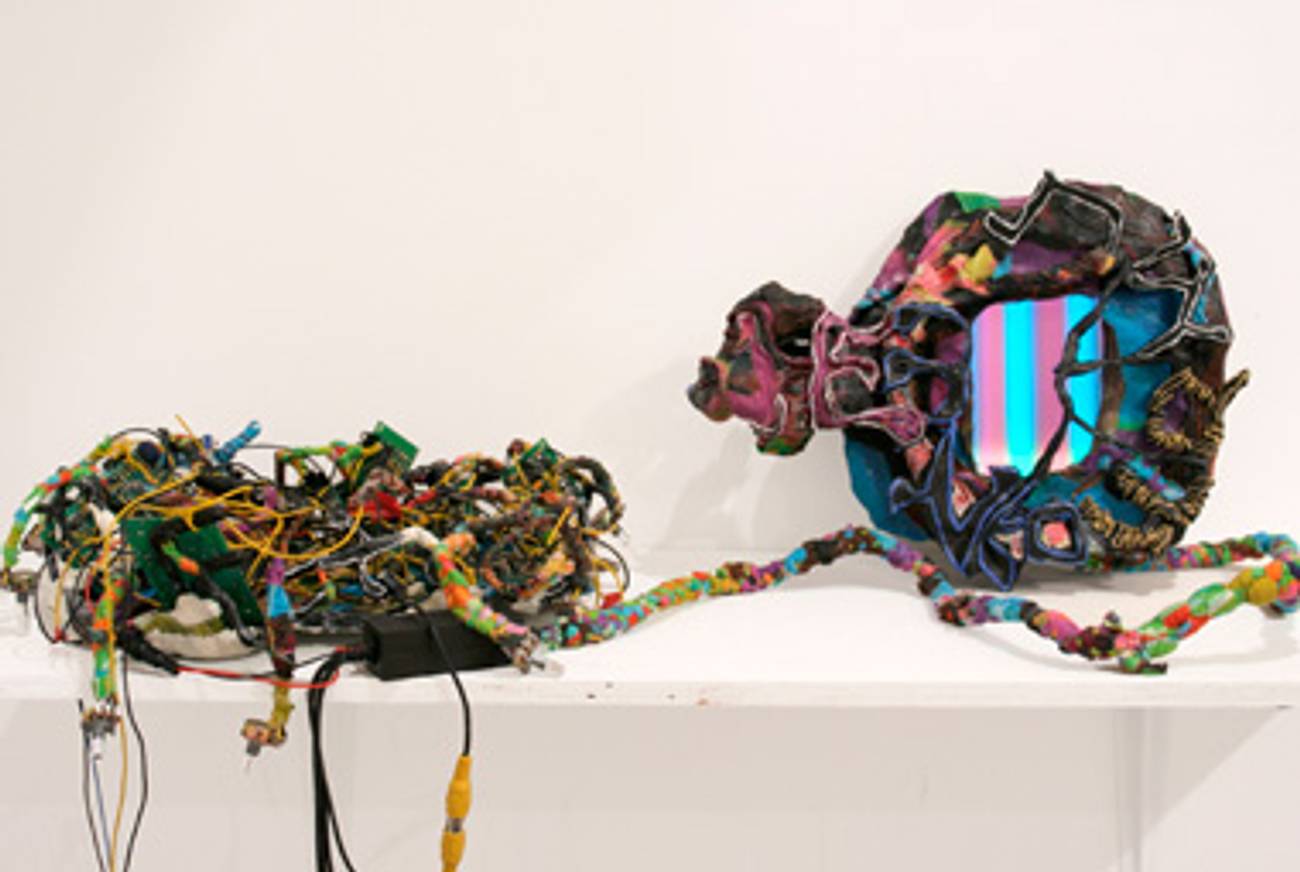Object Lesson
An exhibition at New York’s Jewish Museum redefines the ritual object




“Reinventing Ritual,” the title of the Jewish Museum’s fall exhibition, sounds like a talmudic paradox. Rituals are inflexible, repetitive, established, prescribed. How do they mesh with the often secular, quintessentially American concept of “reinvention”?
As it turns out, the museum is really talking about resuscitating, rather than reinventing, ritual—carving out a place for it in contemporary Jewish life and art. The process is less drastic than it sounds, but still ambitious and labor-intensive. So is the Jewish Museum’s show, which incorporates a range of art and design objects from Jonathan Adler menorahs to sukkahs that double as gardening sheds.
The show’s 58 artists, chosen by the Jewish Museum’s Assistant Curator Daniel Belasco, tailor Judaic rituals to their values, identities, and circumstances. (Most, but not all, of them are Jewish.) They work in every conceivable medium: drawing, sculpture, textile, graphic novel, and industrial design, to name a few.
As Belasco writes in his catalogue essay, the goal of the show is “to propose conceptual and aesthetic terms for the explosion of new Jewish rituals” since the mid-1990s. Those rituals might include same-sex and interfaith marriages, and naming ceremonies for newborn girls.
An unstated, but just as important, objective is to define the wry, irreverent practices of Jews belonging to Generations X and Y—“hipster Judaism,” for lack of a better term. The show’s catalogue includes a cultural timeline, compiled by Tamar Rubin, that lists Adam Sandler, Matisyahu, and Heeb magazine alongside Philip Roth, Tony Kushner and Daniel Libeskind.
The Jewish Museum has been flirting with young, contemporary artists for the past few years, in occasional shows of video art and the annual Hanukkah project “Light x Eight,” but this is its first large-scale effort to acknowledge art made since the early 1990s. In a way, it’s the museum’s answer to “generational” surveys such as the winkingly titled “Younger Than Jesus,” which opened last spring to great acclaim at the city’s New Museum of Contemporary Art.
Belasco divides the new rituals into four categories: Thinking, Covering, Absorbing, and Building. They describe the various actions involved in making or using the artworks: eating, drinking, praying, and so on. This scheme blurs the distinctions between conceptual art and design, conventional and unconventional media, while offering some way to make sense of the variety of art at hand.
It’s also helpful, however, to think of the social phenomena behind the ritual actions.
Feminism is by far the most significant, or at least the “greatest source of new ritual practices,” in Belasco’s words. The show includes many reinterpretations of patriarchal symbols along the lines of Rachel Kanter’s “Fringed Garment,” a tallit modeled after vintage apron patterns, or Helene Aylon’s installation inserting a feminine presence into a traditional beit din, or rabbinical court.
Body art and performance-oriented video are also popular among the show’s female artists. Hadassah Goldvicht updates a ritual associated with Hasidic schoolboys in her video “Writing Lesson # 3,” tasting a Hebrew alphabet made of honey. And in Oreet Ashery’s “Dancing with Men,” the British-born Israeli artist, dressed as an Orthodox Jewish man, infiltrates the male-only zone at the festival of Lag b’Omer. She’s a contemporary Yentl.
Almost as numerous as the works with a feminist slant are those that make reference to recycling and environmentalism. The catalogue essayist Julie Lasky traces this ethos back to the biblical principle of bal tashchit, which forbids the destruction of fruit trees in wartime.
In artistic terms, this means salvaging fragments, working with industrial materials, and giving discarded objects a new purpose. Joe Grand turns steel pipe fittings from Home Depot into a menorah; Jonathan Hopp and Sarah Auslander make Passover plates out of flea-market dishware.
The green theme extends to the exhibition design and installation, which has been exhaustively chronicled on the museum’s blog. The display cases were assembled from slotted, flat-packed plywood; even the wall texts are painted on provisional-looking boards that lean against the wall. The result is that the ornate, dark-wood-paneled galleries of the former Warburg mansion have been converted, as Belasco writes, into an “eco-Bauhaus.”
Many of the works in “Reinventing Ritual” might be described as “Cool Judaica.” In this category are Adler’s retro-kitschy menorah, inspired by New Jersey reform synagogues of the 1960s, and JT Waldman’s Purim comic book Megillat Esther.
Also on view are ritual objects that conform to the principles of “good design,” and would look at home in MoMA’s collection. A handwashing vessel by the Israelis Dov Ganchrow and Zivia has two long spouts, resembling bunny ears, that also serve as handles. It doesn’t “reinvent” the ceremony so much as streamline it.
On the other hand, Azra Aksamija’s “Frontier Vest,” which is in the exhibition catalogue but not the show itself, is both multifunctional and multicultural. This remarkable garment, a Kevlar flak jacket that can be folded in a variety of ways, works as both a tallit and a Muslim prayer rug.
Visitors who are familiar with contemporary art may observe that Belasco’s categories of Jewish ritual—thinking, covering, absorbing, building—apply to a large swath of contemporary art by Jews and non-Jews alike. That’s no accident; the “explosion of ritual” among modern Jews parallels a similar burst of ritual activity in the contemporary art world since the early 1990s. Most of it goes by the name of “Relational Aesthetics,” a movement outlined by the critic Nicolas Bourriaud and taken, broadly, to mean art that involves some social action or transaction. (Familiar examples include taking a candy from a pile left by Felix Gonzales-Torres, or eating curry served by Rikrit Tiravanija.)
Belasco takes Bourriaud’s theories one step further, arguing that communal, ritualistic experiences offer artists a way to shrug off the limitations of cultural, ethnic and religious identity. “This exhibition sharpens the notion of ‘post-identity’ art by, in the case of Jewish culture, focusing on the externalized and shared acts of ritual,” Belasco writes.
Yet the sharpest, most subversive aspect of “Reinventing Ritual” has little to do with labels, theorizing, or the sorts of communal, dinner-party “happenings” that periodically invigorate the gallery scene. Rather, it’s the show’s formal emphasis on craft and D.I.Y. techniques. These approaches, while not exactly news in the broader worlds of art and design, question long-held assumptions about the affinity of Jewish artists for a certain kind of metaphysical abstraction.
As Belasco notes, the critic Harold Rosenberg (no relation) penned a 1966 essay titled “Is There a Jewish Art,” in which he briefly reminisced about his grandmother’s bird-shaped challahs and the dreidels cast in lead by his grandfather. Most of his writing, however, champions more heroic, expressive art forms: the “action painting” of Jackson Pollock and the mystical “zip” paintings of Barnett Newman. Object-making and the pride of craftsmanship were relegated to the past.
The artists in “Reinventing Ritual” reclaim the homemade and revive attention to materials, in pieces of great intricacy (Talila Abraham’s doily-like matzoh basket) or purposeful crudeness (Marit Meisler’s cement mezuzah). They remove the immigrant’s stigma of working with one’s hands. Whether or not they are reinventing rituals, they are certainly expanding the idea of Jewish art.
Karen Rosenberg is a freelance art critic. Her reviews appear weekly in The New York Times, and she has written for New York Magazine, The Village Voice, and Artforum.
Karen Rosenberg is a freelance art critic. Her reviews appear weekly in The New York Times, and she has written for New York Magazine, The Village Voice, and Artforum.